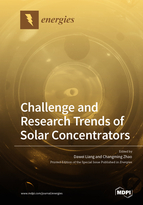Challenge and Research Trends of Solar Concentrators
A special issue of Energies (ISSN 1996-1073). This special issue belongs to the section "A2: Solar Energy and Photovoltaic Systems".
Deadline for manuscript submissions: closed (31 October 2022) | Viewed by 27126
Special Issue Editors
Interests: solid-state lasers; solar power concentration; optics and lasers
Special Issues, Collections and Topics in MDPI journals
Interests: solar-pumped lasers; solar concentrators; solar furnace; optics
Special Issues, Collections and Topics in MDPI journals
Special Issue Information
Dear Colleagues,
As the most abundant renew energy resource, solar energy has attracted interest from scientists all over the world. In order to increase its efficient use, solar concentrators maximizing sun power density are widely used in solar energy research and applications. New progress in solar concentrators is of vital importance for further breakthroughs in the following and many other research areas:
- Solar CPV electricity generation;
- Solar fuel production of H2, syngas, liquid, and gas hydrocarbons;
- Cycles for chemical storage of solar energy with ZnO, CeO2, iron, and silica;
- High added-value material synthesis and/or coating deposits of nanomaterials, new ceramics or metals, foams, catalytic layers;
- High-flux photochemistry and photophysics;
- Characterization of materials’ behavior and properties under extreme conditions;
- Solar pumping of laser for industrial and space applications.
Challenge and research trends of both primary and secondary solar concentrators are key issues for advanced solar energy research. Therefore, the topics of interest include but are not limited to:
- Primary solar concentrators
Parabolic solar concentrators, flat Fresnel lenses, dome-shaped Fresnel lenses, ring array concentrators (RACs), and three-dimensional ring array concentrators (3D RACs).
- Secondary imaging and non-imaging concentrators
Fused silica aspheric lenses, dielectric totally internally reflecting secondary concentrators (DTIRCs), fused silica liquid light guide lenses, two-dimensional compound parabolic concentrators (2D-CPCs), three-dimensional compound parabolic concentrators (3D-CPCs).
- Emerging solar concentrators
Microcompound parabolic concentrators; maximizing the efficiency of luminescent solar concentrators by implanting resonant plasmonic nanostructures; enhancing light conversion efficiency in a luminescent solar concentrator using a prism film; polygonal luminescent waveguides; freeform RXI optics; holographic elements for spectrum-splitting PV systems; 3D-printed concentrators for tracking-integrated CPV modules; freeform waveguides for solar concentrated PV technology; spectrum splitting CSP/CPV collectors with InGaP/GaAs solar cells; new luminescent solar concentrators.
- Solar-pumped lasers with secondary and tertiary concentrators.
Nd:YAG solar-pumped lasers, Ce:Nd:YAG solar-pumped lasers; novel solar laser pumping approaches with solar concentrators; solar laser applications.
Prof. Dr. Dawei Liang
Prof. Dr. Changming Zhao
Guest Editors
Manuscript Submission Information
Manuscripts should be submitted online at www.mdpi.com by registering and logging in to this website. Once you are registered, click here to go to the submission form. Manuscripts can be submitted until the deadline. All submissions that pass pre-check are peer-reviewed. Accepted papers will be published continuously in the journal (as soon as accepted) and will be listed together on the special issue website. Research articles, review articles as well as short communications are invited. For planned papers, a title and short abstract (about 100 words) can be sent to the Editorial Office for announcement on this website.
Submitted manuscripts should not have been published previously, nor be under consideration for publication elsewhere (except conference proceedings papers). All manuscripts are thoroughly refereed through a single-blind peer-review process. A guide for authors and other relevant information for submission of manuscripts is available on the Instructions for Authors page. Energies is an international peer-reviewed open access semimonthly journal published by MDPI.
Please visit the Instructions for Authors page before submitting a manuscript. The Article Processing Charge (APC) for publication in this open access journal is 2600 CHF (Swiss Francs). Submitted papers should be well formatted and use good English. Authors may use MDPI's English editing service prior to publication or during author revisions.
Keywords
- Primary solar concentrators
- Secondary concentrators
- High solar flux
- Fresnel lens
- Solar-pumped lasers







